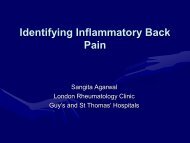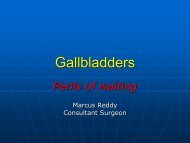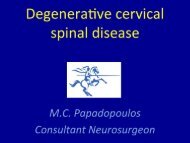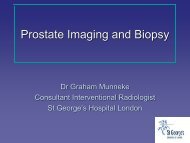Physiotherapy during and after breast cancer ... - Parkside Hospital
Physiotherapy during and after breast cancer ... - Parkside Hospital
Physiotherapy during and after breast cancer ... - Parkside Hospital
- No tags were found...
Create successful ePaper yourself
Turn your PDF publications into a flip-book with our unique Google optimized e-Paper software.
Axillary web syndrome/cording
During chemotherapy• General deconditioning <strong>and</strong> weakness of theskeletal muscle• Cancer related fatigue (CRF)• Breathlessness• Joint stiffness <strong>and</strong> pain/arthralgia• Early menopausal symptoms• Infertility• Bone marrow suppression• Cardio myopathy
Post treatment:late onset ofsymptoms• Post mastectomy pain syndrome• Lymphoedema• Tissue tightness <strong>and</strong> capsular contraction postradiotherapy• Radiotherapy induced brachial plexopathy• Fatigue• Inability to return to work or sport or other dailyactivities
<strong>Physiotherapy</strong> at CCL/<strong>Parkside</strong>• individualised graded exercise programmes ,pacing, planning <strong>and</strong> energy conservation• breathing <strong>and</strong> relaxation techniques• massage <strong>and</strong> soft tissue mobilisations,acupuncture, TENS machines• hydrotherapy <strong>and</strong> Pilates classes• Kinesiotaping, fascial release• advice on diet, exercise, emotionalwellbeing,• MDT approach
Survivorship• 1.2 million long-term <strong>cancer</strong> survivors in the UK(Maddams et al., 2009)• Earlier detection, better treatment• What is their quality of life??• The National Cancer Survivorship Initiative (NCSI)originated from the Cancer Reform Strategy (2007).• The aim: to ensure that those living with <strong>and</strong>beyond <strong>cancer</strong> get the care <strong>and</strong> support they needto lead as healthy <strong>and</strong> active a life as possible <strong>and</strong>for as long as possible.
Benefits• During <strong>cancer</strong> treatment: significant small to moderatebenefits for aerobic fitness, muscular strength, body fatpercentage <strong>and</strong> anxiety.• After <strong>cancer</strong> treatment: significant small to moderateimprovements for aerobic fitness, body weight <strong>and</strong> body fat,quality of life <strong>and</strong> fatigue• <strong>and</strong> large effects for muscular strength (Speck et al.,2010)• preliminary evidence that physical activity performed <strong>after</strong>diagnosis may be associated with improved survival
Wellbeingo43% of all UK<strong>cancer</strong> cases in 2010were attributed tolargely preventablecauses (Cancer Research,UK)oLifestyleoDiet <strong>and</strong> alcoholoExerciseoSmokingoOccupation
References• Cancer Research, UK, 2012,http://publications.<strong>cancer</strong>researchuk.org/publicationformat/formatnewsletter/CancerStats-Newsletter-Sept2012.html• Harris SR, Campbell KL, MnNeeley, L . Upper extremity rehabilitationfor women who have been treated for <strong>breast</strong> <strong>cancer</strong>. <strong>Physiotherapy</strong>Canada 2004;56:202-214• Maddams J, Brewster D, Gavin A, Steward J, Elliott J, Utley M, Møller,H: Cancer prevalence in the United Kingdom: estimates for 2008. Brit JCa 101: 541-547, 2009• National Cancer Survivorship Initiative, 2012, http://www.ncsi.org.uk/• Speck, R., Courneya, K., Mâsse, L., Duval, S. & Schmitz, K. (2010). Anupdate of controlled physical activity trials in <strong>cancer</strong> survivors: asystematic review <strong>and</strong> meta-analysis. Journal of Cancer Survivorship, 4,87-100.












